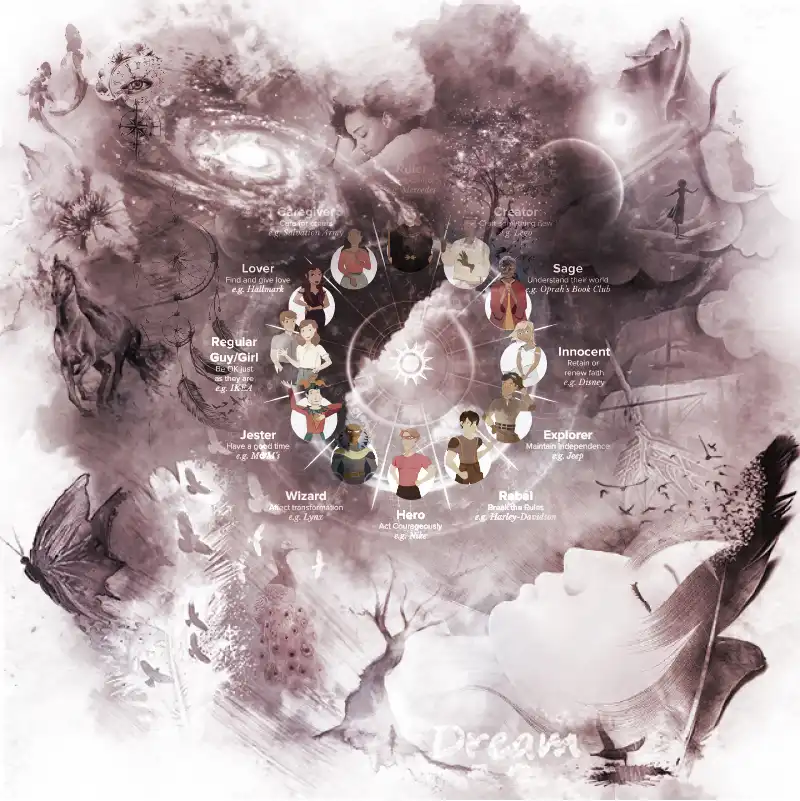C G Jung began studying archetypes and dividing function into thinking, feeling, sensation and intuition. Following various work by his pupils, it became possible to build up a type of ‘map’ of the interaction between all of these functions and to discover where one’s own distortions occur. Each function has a ‘positive’ and ‘negative’ quality which is perhaps better described as ‘greater’ and ‘lesser’. Each of the masculine and feminine sides of the personality has these four functions, thus there are 64 (8 x 8) interactions possible. Where a distortion has occurred, we tend to project onto those around us the archetype with which we have most difficulty (often the Shadow). Consequently there will be a tendency to repeat situations over and over (e.g. the woman who continually finds herself in close relationships with a father-figure type, or the man who continuallv finds himself at odds with women executives) until we learn how to cope with and understand our distortion.
The obverse of this is that, with awareness, one is able to accept other’s projections onto oneself without being affected bv them. Perfect balance would be achieved by using all aspects of the personality as shown below. Kindly Father and Mother are self explanatory. Ogre represents masculine anger used negatively and Destructive Mother may be wilfully destructive, or simply the smothering type that is the mother who prevents the adequate growth of her children. Youth and Princess are the more gentle, fun-loving aspects of the personality while Tramp is the eternal wanderer and Siren is the seductress or sexually active part of femininity. Hero is the self- sufficient Messianic part of the personality, while Amazon is the ‘self-sufficient’ female the efficient business woman type. Villain is the masculine part of the self who uses power for his own ends, while Competitor is die typical ‘women’s libber’ who feels that she has 110 need for men. Priest and Priestess are the powers of intuition used for the ‘greater good’, while Sorcerer uses inner power totally dispassionately and Witch uses that same power rather more emotionally and perhaps negatively.
2- More specifically the feminine archetypes arc:
Kindly Mother
This is the conventional picture of the caring mother figure, forgiving transgression and always understanding. Because much has been made of this side of femininity, until recently it was very easy to overdevelop this aspect at the expense of other sides of the personality. Destructive Mother This woman may be the ‘smothermother’ type or the frankly destructive, prohibitive mother. Often it is this aspect who either actively prevents or because of her effect on the dreamer causes difficulty in other relationships. Princess The fun-loving, innocent childlike aspect of femininity. She is totally spontaneous, but at the same time has a subjective approach to other people. Siren This type is the seductress, the sexually and sensually aware woman who still has a sense of her own importance. In dreams she often appears in historic, flowing garments as though to highlight the erotic image.
Amazon
The self-sufficient woman who feels she docs not need the male: often becomes the career woman. She enjoys the cut and thrust of intellectual sparring. Competitor - She is the woman who competes with all and sundry both men and women - in an effort to prove that she is able to control her own life. Priestess - This is the highly intuitive woman who has learnt to control the flow of information and use it for the common good. She is totally at home within the inner world.
Witch
The intuitive woman using her energy to attain her own perceived ends. She is subjective in her judgement and therefore loses her discernment.
The masculine archetypes are: Kindly Father This side of the masculine is the conventional kindly father figure who is capablc of looking after the child in us. but equally of being firm and fair. Ogre This represents the angry; overbearing, aggressive and frightening masculine figure. Often this image has arisen because of the original relationship the dreamer had with their father or father figure.
Youth
The fun-loving, curious aspect of the masculine is both sensitive and creative. This is the ‘Peter Pan’ figure who has never grown up.
Tramp
This is the real freedom lover, the wanderer, the gypsy. He owes no allegiance to anyone and is interested only in what lies around the next corner. Hero The hero is the man who has clcctcd to undertake his own journey of exploration. He is able to consider options and decide his next move. Often he appears as the Messianic figure in dreams. He will rescue the damsel in distress, but only as part of his growth proccss.
Villain
The villain is completely selfishly involved, not caring who he tramples on in his own search. He is often the aspect of masculinity women first meet in everyday relationships, so can remain in dream images as a threatening figure if she has not come to terms with his selfishness.
Priest
The intuitive man is the one who recognises and understands the power of his own intuition, but who usually uses it in the services of his god or gods. He may appear in dreams as the Shaman or Pagan priest.
Sorcerer
This is the man who uses discernment in a totallv dis- passionate way for neither good nor evil, but simply because he enjoys the use of power. In his more negative aspect he is the Trickster or Master of unexpected change.
3- Spiritually, when we have access to all the archetypes, we are ready to become integrated and whole.

